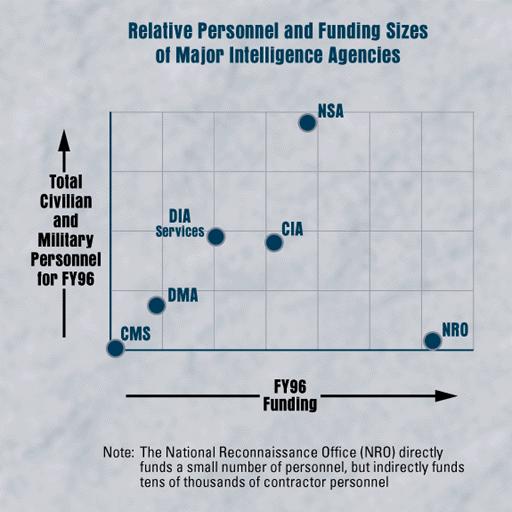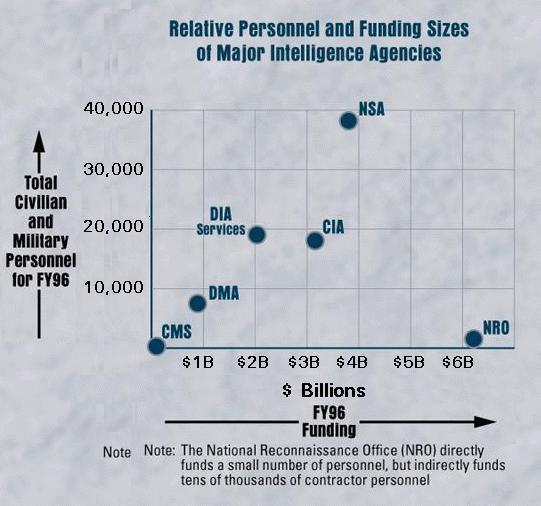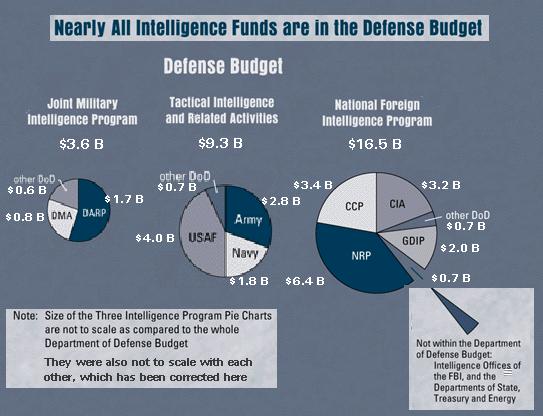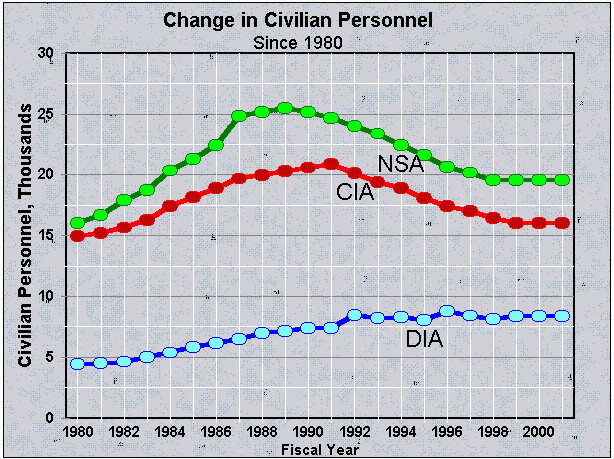



The report concluded in Chapter 13 The Cost of Intelligence that reductions in the overall intelligence budget were possible:
The Commission nonetheless believes the staff's review demonstrated that reductions to the existing and planned intelligence resources may be possible without damaging the nation's security.... the Commission believes cost savings can be achi eved if the Intelligence Community adopts the management practices and implements the cooperative arrangements summarized earlier in this chapter. Those actions, together with pruning unnecessary requirements and unproductive systems and activities, could free significant resources.The Report also recommended official acknowledgement of the overall $28 billion intelligence budget, though it concluded that the budgets of individual agencies should remain unacknowledged.
But the report itself discloses the budgets and personnel levels of several intelligence agencies. Apparently it is permitted for the foreign adversaries [and the public] to know this information, as long as the government is not required to officially acknowledge the fact that the public has this information, or to engage in a dialog with the taxpayers as to how their money is being spent.
In Chapter 14 Accountability and Oversight the Commission states:
After weighing the arguments, the Commission concludes that the President should disclose to the public the overall figure for the intelligence budget. The Commission believes this can be done in manner that does not raise a significant security concern. While disclosure would necessarily convey limited information, it would let the American public know what is being spent on intelligence as a proportion of federal spending. This in itself is a worthwhile purpose, and may, to some degre e, help restore the confidence of the American people in the intelligence function. A number of foreign governments, including the British and Australian, have disclosed their intelligence budgets to the public without adverse effect. The Commission belie ves it can be done here as well.
The Commission recommends that at the beginning of each congressional budget cycle, the President or a designee disclose the total amount of money appropriated for intelligence activities for the current fiscal year (to include NFIP, JMIP, and TIARA) and the total amount being requested for the next fiscal year. Such disclosures could either be made as part of the President's annual budget submission or, separately, in unclassified letters to the congressional intelligence committees. No further disclosures should be authorized. [emphasis added]However, in Chapter 13 The Cost of Intelligence the Report notes:
Although intelligence funding remains classified, Figure 2 depicts the relative funding levels of the major intelligence agencies and their personnel levels for FY 1996. NSA, CIA, and DIA (and the Service intelligence units) have the largest n umber of personnel; the NRO, on the other hand, has the highest level of funding of any program in the Community, but virtually no federal workforce. Its work is accomplished primarily by contractors in the private sector.

DMA operates under a total annual budget appropriation of some $826 million (Fiscal Year 1995).... DMA's work force includes approximately 7,100 civilians and 260 military personnel.This permits ready callibration of the X and Y coordinates of this graph.



| Table 7-1: Increasing Budget Formulation Responsibilty for NFIP Program Managers in each of the Intelligence Disciplines. | |||
|---|---|---|---|
| Percentage of national (NFIP) discipline activity budgeted by each program manager | |||
| Intelligence Discipline | Proposed NFIP Program Manager | Today | Commission's Plan |
| Imagery Intelligence | Director, National Imagery and Mapping Agency | 3% | 100% |
| Signals Intelligence | Director, NSA | 52% | 100% |
| Measurement and Signature Intelligence | Director, DIA | 87% | 100% |
| Clandestine Human Intelligence | Deputy DCI for CIA | 96% | 100% |
| Notes: Two proposed program managers--the Director, National Imagery and Mapping Agency and the Deputy DCI for CIA--are positions which do not currently exist, but have been endorsed by the Commission.
The 3% figure, associated with imagery intelligence, refers to funds currently budgeted by the Director, CIO. The 96% figure, associated with clandestine human intelligence, refers to funds currently budgeted by the Executive Director, CIA. | |||
| FAS Improved Table 7-1: Budget Formulation Responsibilty for NFIP Program Managers in each of the Intelligence Disciplines. | |||||
|---|---|---|---|---|---|
| Intelligence Discipline | NFIP Program Manager | PM Agency | Other Agencies | Other Budget | Total NFIP |
| Imagery Intelligence | Director, CIO / NIMA | $0.13 B | NRO, DMA |
$4.2 B | $4.3 B |
| Signals Intelligence | Director, NSA | $1.7 B | ??? | $1.7 B | $3.4 B |
| Measurement and Signature Intelligence | Director, DIA | 87% | CIA | 13% | 100% |
| Clandestine Human Intelligence | Deputy DCI for CIA | $1.0 B | DIA | $0.04 B | $1.0 B |
|
Notes:
The $0.13 figure, associated with imagery intelligence, refers to funds currently budgeted by the Director, CIO. The $4.3 B would include both DMA, and a significant fraction of NRO. The SIGINT figures suggest that only about half of NSA's budget is SIGINT, with the remainder COMSEC. It is not clear which agencies would account for the other half of the SIGINT program. The total MASINT budget is unknown, though it is believed to be small, of the order of a few hundred million dollars, or thereabouts. The clandestine human intelligence figures are rough estimates, with about 5,000 Clandestine Service personnel at CIA, and about 200 clandestine collection personnel out of the total of about 1,000 in the Defense HUMINT Service. | |||||


